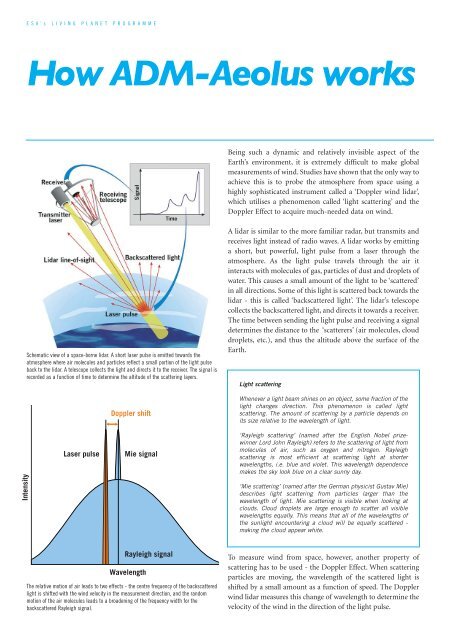ADM-Aeolus brochure (pdf) - ESA
ADM-Aeolus brochure (pdf) - ESA
ADM-Aeolus brochure (pdf) - ESA
You also want an ePaper? Increase the reach of your titles
YUMPU automatically turns print PDFs into web optimized ePapers that Google loves.
<strong>ESA</strong>’s LIVING PLANET PROGRAMME<br />
How <strong>ADM</strong>-<strong>Aeolus</strong> works<br />
Schematic view of a space-borne lidar. A short laser pulse is emitted towards the<br />
atmosphere where air molecules and particles reflect a small portion of the light pulse<br />
back to the lidar. A telescope collects the light and directs it to the receiver. The signal is<br />
recorded as a function of time to determine the altitude of the scattering layers.<br />
The relative motion of air leads to two effects - the centre frequency of the backscattered<br />
light is shifted with the wind velocity in the measurement direction, and the random<br />
motion of the air molecules leads to a broadening of the frequency width for the<br />
backscattered Rayleigh signal.<br />
Being such a dynamic and relatively invisible aspect of the<br />
Earth’s environment, it is extremely difficult to make global<br />
measurements of wind. Studies have shown that the only way to<br />
achieve this is to probe the atmosphere from space using a<br />
highly sophisticated instrument called a ‘Doppler wind lidar’,<br />
which utilises a phenomenon called ‘light scattering’ and the<br />
Doppler Effect to acquire much-needed data on wind.<br />
A lidar is similar to the more familiar radar, but transmits and<br />
receives light instead of radio waves. A lidar works by emitting<br />
a short, but powerful, light pulse from a laser through the<br />
atmosphere. As the light pulse travels through the air it<br />
interacts with molecules of gas, particles of dust and droplets of<br />
water. This causes a small amount of the light to be ‘scattered’<br />
in all directions. Some of this light is scattered back towards the<br />
lidar - this is called ‘backscattered light’. The lidar’s telescope<br />
collects the backscattered light, and directs it towards a receiver.<br />
The time between sending the light pulse and receiving a signal<br />
determines the distance to the ‘scatterers’ (air molecules, cloud<br />
droplets, etc.), and thus the altitude above the surface of the<br />
Earth.<br />
Light scattering<br />
Whenever a light beam shines on an object, some fraction of the<br />
light changes direction. This phenomenon is called light<br />
scattering. The amount of scattering by a particle depends on<br />
its size relative to the wavelength of light.<br />
‘Rayleigh scattering’ (named after the English Nobel prizewinner<br />
Lord John Rayleigh) refers to the scattering of light from<br />
molecules of air, such as oxygen and nitrogen. Rayleigh<br />
scattering is most efficient at scattering light at shorter<br />
wavelengths, i.e. blue and violet. This wavelength dependence<br />
makes the sky look blue on a clear sunny day.<br />
‘Mie scattering’ (named after the German physicist Gustav Mie)<br />
describes light scattering from particles larger than the<br />
wavelength of light. Mie scattering is visible when looking at<br />
clouds. Cloud droplets are large enough to scatter all visible<br />
wavelengths equally. This means that all of the wavelengths of<br />
the sunlight encountering a cloud will be equally scattered -<br />
making the cloud appear white.<br />
To measure wind from space, however, another property of<br />
scattering has to be used - the Doppler Effect. When scattering<br />
particles are moving, the wavelength of the scattered light is<br />
shifted by a small amount as a function of speed. The Doppler<br />
wind lidar measures this change of wavelength to determine the<br />
velocity of the wind in the direction of the light pulse.

















